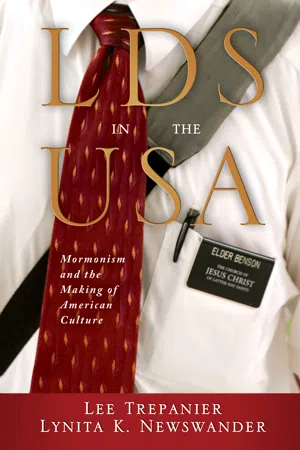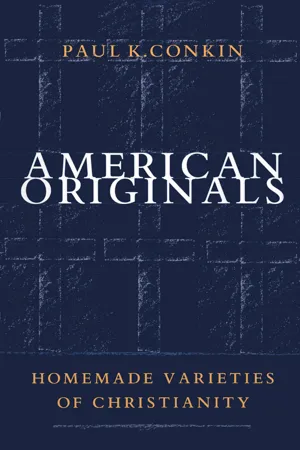History
Mormon migration
Mormon migration refers to the movement of members of the Church of Jesus Christ of Latter-day Saints (LDS) from the eastern United States to the Salt Lake Valley in Utah during the mid-19th century. Fleeing religious persecution, the Mormons sought a place where they could practice their faith freely. The migration was a significant event in American history, shaping the development of the western frontier.
Written by Perlego with AI-assistance
Related key terms
3 Key excerpts on "Mormon migration"
- eBook - ePub
LDS in the USA
Mormonism and the Making of American Culture
- Lee Trepanier, Lynita K. Newswander(Authors)
- 2016(Publication Date)
- Baylor University Press(Publisher)
According to one historian, the Mormon religion “was infused with a great deal of spread-eagle American nationalism at a time when Manifest Destiny had become the watchword of the nation.” 17 This is apparent in the westward movement of the Church, eventually into what was at the time Mexican territory, and its significant role in settling land west of the Rocky Mountains. This movement and industry were guided by a desire among the Mormons for a land of their own, and largely motivated by their pursuit of the freedom to rule themselves at a safe distance from those who would “hurt or make afraid.” 18 Furthermore, early Church members saw themselves as part of the divine destiny of the United States, and they took the ideology of expansion personally, implementing it in their communities and even in their own homes. For example, non-Mormons in early America generally had much larger families than their counterparts in England and Europe. Tocqueville noted that this might be because so much land needed to be filled, with no scarcity of resources or potential inheritance present to check growth. It was not unusual for American families of the period to have six, seven, or more children—even with a high rate of infant mortality on the frontier. 19 But the Mormons outdid themselves when they adopted wholeheartedly this American ideal. Perhaps because they were intent on populating their own cities and territories, Mormons had extremely large families, even compared to their contemporaries. Of course, much of this population boom was facilitated by the practice of polygamy (a practice officially ended in 1890), which allowed one man to father as many as thirty or more children (sometimes sixty or more). 20 Mormon cultural practices and theological doctrines such as these reflected and supported a nineteenth-century American perspective on the world - eBook - ePub
American Originals
Homemade Varieties of Christianity
- Paul K. Conkin(Author)
- 2000(Publication Date)
- The University of North Carolina Press(Publisher)
In the late winter of 1847 Young formed a pioneer camp of about 150 for the final advance beyond the mountains. These celebrated pioneers took the easiest possible route—through Fort Laramie, over the south pass, and then across what is now southwest Wyoming into the valley of the Great Salt Lake. They created a new trail (soon worn by Mormon travelers) from Council Bluffs to Laramie and then departed the Oregon Trail for their descent into the valley (on modern maps the whole is identified as the Mormon Trail). The advance party only entered the valley on July 21, too late to plant food crops. An ill Brigham Young arrived two days later. By July 24 the whole camp was on the site of what became Salt Lake City and had dedicated the land. In the exultation of the moment the saints renewed their covenant and rebaptized one another (such rebaptisms were later ended by the church). Even in this first, foreshortened summer the saints built a fort, named streams, explored several sites for villages, and began building small dams and irrigation canals, ensuring crops in 1848. Young and others helped plat the city (using some designs earlier drafted by Joseph Smith), with broad streets, large rectilinear blocks, and a choice location for the future temple. Small bands of Mormons came from California, including some of the Mormon Battalion joined by Mormons from Mississippi who had taken a ship to California. By the fall almost 1,500 had crossed in wagons from winter camp, making over 2,000 in the valley by the end of the year. But Young and many of the original pioneers hurried back east to lead the great migration in 1848.In 1848 most Mormons in western Iowa moved to Utah in a series of camps, a migration that continued year after year for the next decade. Only in one case, that of several handcart companies that tried crossing in 1856, did the migration come close to disaster. A few Mormons decided not to go on to Utah in spite of admonitions from Young, and one Mormon missionary to the Indians, Alpheus Cutler, formed a small schismatic group (Culterites) in Iowa that still survives. In most cases the camps were disciplined and well organized, with better than normal relationships with the Indians. After 1848 an increasing proportion of the migrants were European immigrants, who came at the request of Young to the gathering place for all the saints. European converts had another role: as much as their resources permitted, they collected funds to help finance this huge migration.Back at Salt Lake City, the early residents were able to plant their irrigated grain crops in 1848, only to have the fields threatened by a cyclical grasshopper explosion (these are now called Mormon crickets). It seemed a miracle, an omen, when seagulls appeared and ate most of the “crickets,” another, often exaggerated part of the great Mormon epic. The grain harvest was still limited but the pioneers celebrated it by a festival in the fall. The massive arrival in 1848 led to the expansion of settlement throughout the larger valley and the formation of new towns. By 1849 the church had divided the settlements into stakes and wards. It also set up a permanent emigration fund to help both American and European members cross the plains. The dire poverty and short food supplies of 1848 yielded to some prosperity in 1849, as Mormons were in a perfect position to outfit those flocking to the new goldfields of California. Young Mormon men, some from the Mormon Battalion, remained in the minefields of California, sent a growing supply of gold to Salt Lake City, and provided the basis of a short-lived mint established there by Brigham Young. - eBook - ePub
The Burned-over District
The Social and Intellectual History of Enthusiastic Religion in Western New York, 1800-1850
- Whitney R. Cross(Author)
- 2015(Publication Date)
- Cornell University Press(Publisher)
It seems conservative to estimate that of Mormons brought into the church from the Burned-over District at least three-fourths must have been gathered by returning itinerants between 1831 and the early fifties. Yankee groups in Ohio, Pennsylvania, and New England itself responded similarly, but less intensively, and after 1850 a substantial portion of new members came from England and Scandinavia. Obviously, then, Mormonism should not be called a frontier religion in terms of the persons it appealed to, any more than it should in terms of its origin.To be sure the church existed generally on the frontier and kept moving westward with the tide of settlement. It also carried into the West a number of ideas characteristic of the Burned-over District. Its location was determined by the fact that the evangelistic-mindedness from which it developed in the beginning, and which constantly fed it with members, had little tolerance for such an unorthodox offspring, and drove the Saints by its persecution along their westering course. But neither the organization of the church, nor its personnel, nor its doctrines were frontier products. All belonged rather to that Yankee, rural, emotionalized, and rapidly maturing culture which characterized western New York so markedly in the second quarter of the nineteenth century.1 Fawn M. Brodie, No Man Knows My History: The Life of Joseph Smith, the Mormon Prophet (New York, 1945), 1-5, 7-9.2 See maps I and II.3 Palmyra Herald and Canal Advertiser, July 17, 1822; Western Farmer (Palmyra), Summer, 1822, passim; Wayne Sentinel (Palmyra), Oct., Nov., 1823.4 Brodie, No Man Knows, 9-11.5 Rev. James H. Hotchkin, A History of the Purchase and Settlement of Western New York, and of the…Presbyterian Church in That Section (New York, 1848), contains outline histories of each church in the denomination west of Madison County. Tabulated geographically, it provides a reliable guide to revival cycles and locations.6 Western Farmer, Feb. 27, 1822; Palmyra Herald, Jan. 15, 1823.7 John H. Evans, Joseph Smith, An American Prophet (New York, 1945), 30-32; Brodie, No Man Knows, 10, 11, 55. Land values ran from twenty to thirty-five dollars an acre by 1833, Rochester Daily Advertiser,
Learn about this page
Index pages curate the most relevant extracts from our library of academic textbooks. They’ve been created using an in-house natural language model (NLM), each adding context and meaning to key research topics.


